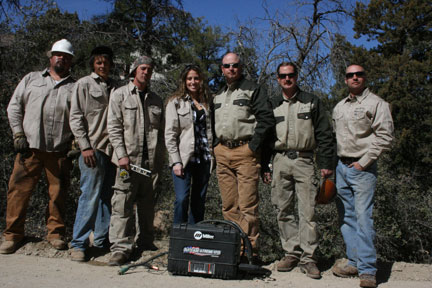 |
From Left to Right, Hot Az Hell staff Larry Gomez, Robert Gomez, Brian Rice, Theresia Moreland, Shawn Moreland, Chris Rice and Steve White.
|
The Arizona Department of Transportation is implementing a new standard in pedestrian safety by installing handrail along state thoroughfares with drop-offs exceeding 18 in. This includes retaining walls, drainage structures, highway shoulders and sidewalks. This exercise in fall prevention and safety has provided a steady flow of work for contractors capable of fabricating and welding steel pipe railings.
Hot Az Hell Welding of Chino Valley, Arizona seized the opportunity and has become one of the leading installers of this handrail: the company will install more than 31,000 linear feet of it in 2009. Shawn Moreland and Chris Rice, the company’s owner and superintendent, respectively, are both experienced pipeline welders who naturally gravitate towards Stick welding. A switch to flux cored welding by adding Miller’s SuitCase™ X-TREME™ 12VS wire feeder, however, has yielded results that allow Hot Az Hell Welding to get more work done and be more competitive: a 33 percent increase in productivity, lower consumable costs, less cleanup, a better distribution of labor and a substantial return on investment.
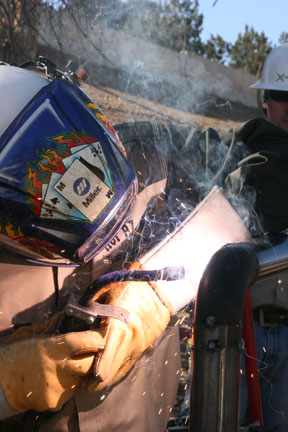 |
Hot Az Hell owner Shawn Moreland welds handrail in Prescott, Arizona. Switching to flux cored versus Stick has allowed his company to increase productivity by more than 33 percent.
|
“Between wages, consumables, fuel costs and actual production, I figure we’re saving at least $650 to $800 for every 100 ft. of handrail,” claims Moreland. “And after seeing what this machine can do, I can honestly say that soon we will double our footage amounts in an 8-hour day.”
Using the conservative end of Moreland’s estimate ($650) and the total amount of handrail work the company is contracted for in 2009 (31,000 ft.), and factoring in the equipment investment (roughly $4,000 for two feeders), the new equipment will pay for itself within two weeks and add $201,500 to the company’s profitability.
What’s in a Name?
Moreland admits that his company’s name has raised a few eyebrows. But it’s more than marketing sense (his company’s shirts are a hit among bouncers, bikers and bartenders throughout Arizona) or a need to be outrageous that spurred the name, it’s a nod to the trade he has devoted a lifetime to and the family that got him started in this business.
“The first time I told my dad I wanted to be a welder,” says Moreland, whose father, Harold, is a career pipeline welder, “he tried to talk me out of it. He kept telling me it was ‘hotter than hell,’ etc. And then, just based on process, you typically look at the molten metal you’re joining and you’re like ‘man, that’s hot as hell!’ You may not like the name, but you’ll never forget it.”
Moreland and Rice cemented their relationship while working together as natural gas pipeline welders. One night, Rice was called out on a pipeline hit that took all night to repair. Moreland offered to join him. The two have been inseparable ever since. While the two joke that Moreland brings the business sense and Rice offers quality control, the truth is that both men are experienced welders with numerous certifications that allow them to tackle many projects, including: structural steel, D1.1 bridging, natural gas pipeline, aluminum, and stainless steel.
Flux Cored Wins Over Stick Devotees
All handrail fabrication is done in the field since each run has different slopes and measurements. Moreland and his crew start out with a trailer of .154 in.-thick Schedule 40 carbon steel pipe (1-1/2- to 2-in. diameter) and measure, cut, notch and tack each length. Once fit-up is ensured, a welder follows behind and lays the weld.
Before purchasing the SuitCase wire feeders, Moreland and his crew relied on the Stick welding capabilities of their Bobcat™ 250 and Trailblazer® 302 welding generators. Welds were made with 1/8-in. 6010 electrodes and each joint required at least three passes. One crewmember devoted his time to grinding spatter and slag from each joint. Now, Moreland and his crew run the SuitCase wire feeder off of the welding generators. By adding a SuitCase wire feeder and switching to flux cored welding, Hot Az Hell Welding joins the pipe with one pass, reduces spatter and eliminates the need for excessive grinding.
The flux cored wire (E71T-11) offers a higher deposition efficiency than Stick electrodes. A 6010 electrode only deposits about 60 percent of its mass into the weld joint. The rest of the electrode is lost through its stub. A 50-lb. box of 6010 electrodes only deposits 30 lb. of weld metal. Flux cored wires like E71T-11, however, deposit about 75-80 percent of its total mass. Moreland actually purchases less filler metal per joint due to the higher deposition efficiency.
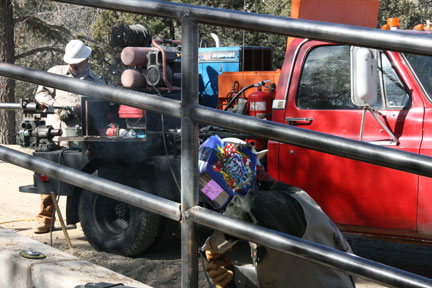 |
Shawn Moreland Welds while Larry Gomez cuts pipe in the background. Moreland relies on Bobcat™ and Trailblazer™ engine driven welding generators to run all his power tools and weld simultaneously.
|
“With Stick welding, you’re in there baby-footing 1/8-in. rod for three passes,” says Moreland, “and you’re actually depositing a lower percentage of metal into the joint (compared to flux cored). This change has really stepped up our production.”
Whether running a crew of three, four or five, Stick welding required Moreland to devote an entire worker’s time to grinding spatter and dressing the weld. With a crew of three, he often couldn’t spare labor to grind (he needed a cutter, notcher, and welder) so that crew would spend four hours the next day doing nothing but cleanup. He could spare a guy to grind all day on his crews of four or five, but that creates one whole day of labor spent on a non-productive task. Now, the welder simply knocks off the slag with a wire brush and the joint is complete. Moreland can reassign the grinder to a productive task, such as welding or cutting: he gets more work done with the same amount of workers.
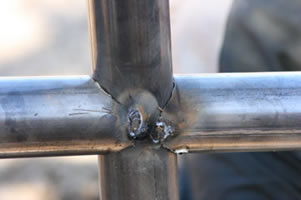 |
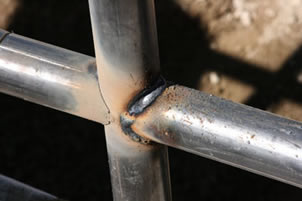 |
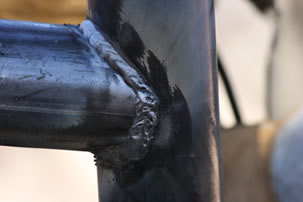
From top to bottom: A tacked joint prior to welding.A finished, 3-pass Stick weld. Notice the spatter. A finished, one pass MIG weld.
|
|
Moreland attributes a 33 percent increase in productivity to these factors. When you combine that 33 percent increase in productivity (charging same cost per foot but getting 33 percent more work done each day) with the money they save in consumables (fewer grinding disks) and filler metal (higher deposition efficiency), and factor in savings passed on to the customer, Moreland puts his daily savings between $650 and $800.
“When you’re able to go out and get the production that you were getting with five guys and now you can get it with three, that has opened a lot of doors for us. And it’s going to be 100 percent attributed to that fact that we’re using this system now.”
Easier Training Spurs Productivity, Profitability
Moreland states that the SuitCase X-TREME 12VS is easier to train new recruits with than with Stick. Training and keeping new welders interested has been a burden on the welding industry for years. Moreland claims that machines like the SuitCase X-TREME 12VS make it easier to train new welders and immediately make them productive on the jobsite, which adds to a sense of accomplishment and pride in the work.
"It’s easy to learn,” he says. “We have a guy who had never picked up a MIG gun in his life and he came out here and laid a top-notch coping weld on galvanized and it looked like a machine weld.”
The SuitCase X-TREME 12VS features no-nonsense controls with digital displays that make it easy to set and maintain parameters. Easier training doesn’t just add to productivity; it’s another way for Hot Az Hell to stay competitive in the market.
“We don’t have to go out and look for a 20-year rig hand that’s going to want $75 an hour to make a weld. Our guys understand the competitive market right now, and that with an organization of our size, everybody has to wear all the hats. Nobody is above notching pipe, and everyone is expected to learn how to weld. This allows us to train guys at a lower wage scale than we would have in the past.”
Flux Cored Improves Weld Quality, Speed
Welding with a 1/8-in. 6010 Stick electrode in this application proved tedious and time consuming, especially when welding on thinner materials. Some of the pipe Moreland welds is as thin as .060 in. When striking an arc with a Stick rod in an application that a) involves thin material and b) includes gaps, the arc may blow through the material. To combat this, welders increase travel speeds so as not to put too much heat into the weld. This creates agitation in the weld puddle and creates spatter, and, in this application, it takes at least three passes to completely fill the gap.
By switching to wire welding with Hobart Brothers’ .045-in. diameter Fabshield® 21B flux-cored wire (AWS E71T-11), Moreland and his welders are able to turn down the heat and ensure proper penetration and fill. Fabshield 21B is a self-shielded, all-position wire that is perfect for the outdoor, out-of-position welding required in this application. The SuitCase X-TREME 12VS features a wider voltage range (14-48 volts) that allows welders to tailor the arc to the wire and the thickness of the pipe. In this application, superintendent Chris Rice prefers the voltage set at approximately 25 volts with a wire feed speed near 148 inches per minute. This creates a steady arc with minimal spatter and lets him fill the joint in one pass and in 1/3 of the time.
“With the SuitCase it’s ‘zip and you’re done’,” says Moreland. “When Miller came up and showed us this I looked at Chris and said ‘we’ve just changed our operation completely.’ And we did.”
 |
The portable, lightweight SuitCase™ X-TREME™ 12VS wire feeder allows Moreland and his crew to easily move from joint to joint.
|
The Right Tool for the Right Job
In addition to the massive handrail project, Moreland sees the SuitCase X-TREME 12VS as a solution that will help him in all of his construction and structural work. Its light (35 lb.), compact design makes it an ultra-portable MIG welding option, and its polypropylene case makes it resistant to the hot, dry and dusty weather found in Arizona. Its internal circuit board is potted to resist dust, vibrations and other contaminants. It’s the perfect machine to survive Arizona’s harsh weather conditions while still pushing Hot Az Hell Welding’s productivity forward.
“The minute this thing hits the ground we’re saving money,” says Moreland. “In this business you either evolve or you die, and we’re evolving. I’m really excited to see what this will do on a 12,000 ft. run. The sky is the limit with this thing.”
With new ways of increasing productivity and a solid team beside him, Moreland is ready for new and exciting challenges that will take his company to the next level.
“Between my parents (Harold and Priscilla, who now approve of his welding career), my wife Theresia, and a great crew, I couldn’t ask for more.”
Welding Generator with Two Generators Improves Performance
Hot Az Hell Welding’s success depends largely on the ability to run tools simultaneously to stay ahead of schedule. Since all the work is done in the field, handrail installation requires enough power to run chop saws, notchers and welders at the same time. Both the Bobcat™ 250 and Trailblazer® 302 capably run all of the tools, but the Trailblazer 302 has an added advantage by actually having two built-in generators (one for welding, one for power tools). The Hot Az Hell staff is able to run all of its tools and weld with the SuitCase wire feeder without noticing any drops in power or the welding arc.
“Our parameters with the SuitCase are very exact,” says Moreland, “you want them exactly where you need them. We were worried that, since we had guys running chops saws, air compressors and notchers, that there would be problems when we used tools simultaneously. With this setup, you can’t tell. You’re oblivious to other tools while welding. It’s amazing.”
The Trailblazer 302 features two generators: a four-pole, three-phase generator for welding and a separate 11,000-watt generator for power tools. Having two separate generators ensures no interaction between power tools and the welding arc. And 11,000 watts of Accu-Rated™ power ensures enough usable peak power to start everything from chop saws to plasma cutters.
“Every time one of their guys triggers a chop saw with the Trailblazer, the guy welding isn’t going to notice it. The arc will remain smooth,” says Duane Smith, branch manager, Praxair, Prescott, Arizona. “Other welding generators interfere with the welding arc when a power load is added to the machine. The Trailblazer eliminates that problem.”